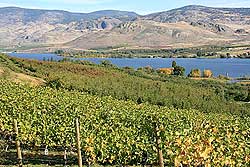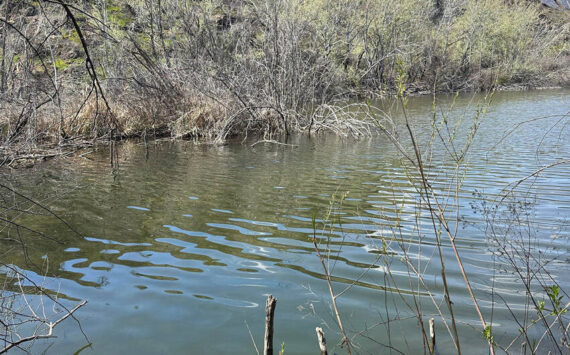
Photo by Rick BramanGroups such as the Lake Osoyoos Association and the Osoyoos Water Quality Society are working to preserve the water quality in Lake Osoyoos, viewed here from a vineyard in Oroville. The Lake Osoyoos Association recently heard there may
OROVILLE – After electing a slate of officers at their Thursday, Nov. 1 meeting, the newly reformed Lake Osoyoos Association was told by a representative of the Department of Ecology that there would be some state help available to monitor lake quality.
Monitoring and testing Lake Osoyoos’ water quality for plant and animal life and for human use and consumption was adopted as the association’s number one goal. Other goals include determining the causes of water pollution and advising the public and appropriate government agencies of their findings, as well as helping these agencies in carrying out programs to improve the quality of the lake. Monitoring lake management and shoreline development and public education are the group’s other main goals.
Mark Peterschmidt, Environmental Specialist for Ecology said he was excited to hear the Lake Osoyoos Association (LOA) was “firing up again” and that his agency was hoping to help the group with its proposed volunteer lake monitoring.
“Ecology has not done any long term monitoring of lake quality in a number of years,” said Peterschmidt, who works with Ecology’s Water Quality Program out of the Yakima office.
“We cover from the Cascades to the Columbia,” said Peterschmidt, adding that two other groups, a homeowner’s group around Lake Wenatchee and a sportsman’s group at Lake Chelan, have also recently indicated they would like to do some lake monitoring in their respective areas.
“Ecology has funds available to purchase some equipment to establish simple water quality measurements to show trends over a long period of time. Lake Osoyoos has the advantage of our northern friends in the Osoyoos Lake Water Quality Society,” he said, referring to a group north of the U.S.-Canadian border that has been doing monitoring of the international lake for several years.
“We can expand the data we have and compliment the data they have from the north,” said the Environmental Specialist.
A letter to the LOA from the Canadian society’s interim president, Michelle Jefferson, echoed that sentiment.
“The momentum created by the Osoyoos Lake Water Science forum has offered us all an opportunity to redouble our efforts on behalf of our shared lake,” writes Jefferson. “As we all know, we all live downstream and only by working together can we insure that ‘our’ lake and the water coming in and going out improves.”
Jefferson went on to say that the society hopes to share information, volunteers and even projects in the not-so-distant future so the two groups’ efforts reflect the “best practices of any lake stewardship group either in the U.S. or Canada.”
Peterschmidt said although funding was not enough to provide the U.S. group with a boat, help could include small “over the boat” type water quality monitoring equipment, collection bottles and some automated equipment.
This data could then be uploaded to a special website maintained by the Department of Ecology. He suggested using science students at the high school to upload the data and to work with the group.
“We need consistency to maintain the data quality in the future,” said Peterschmidt, who adds that some of the water testing could include keeping track of temperatures at different levels in the lake and the amounts of dissolved oxygen, chlorophyll, nitrates, phosphates and plankton life in the water.
Peterschmidt said a 2002 fish tissue analysis done on the Okanogan River and Lake Osoyoos indicated that there were some residual levels of DDT, a pesticide banned in 1973, in the local fish.”However, in the area’s fish the issue was not large enough to issue a fish advisory, while in other Washington lakes it has been,” he said, adding the state plans to readdress the issue again this year and hopes a downward trend will be seen.
“The challenges you face are a growing population and expansion in the area. Each of us has to have less of an effect on the lake just to maintain the current water quality levels,” said Peterschmidt. “We need to keep an eye on how expansion occurs and how we impact the water quality.”
The group elected Mike Cantwell as its president and John Moran will serve as vice president. Raleigh Chinn will serve as secretary and Stan Porter as treasurer. Howard Zosel and Linda Colvin have agreed to be on the board of directors.
“As John said a couple of months ago, it is kind of appropriate we were all nominated in an old railroad station,” joked the new president.
Moran and Cantwell reported on their recent attendance at a Washington Lake Protection Association meeting held in Chelan.
They told the group that people who live on the lake and have septic systems should use liquid washer soap, rather than powder because the powder has higher concentrations of phosphates.
They also discussed some of the algae types that have appeared and caused problems at other lakes. Both men described a recent algae bloom on Lake Osoyoos as “scary” and “unprecedented.”
“We’re just lucky that Lake Osoyoos has both an inlet and an outlet,” said Cantwell.
Moran said the zebra mussel was an invasive species that is wreaking havoc in lakes around the eastern United States and killing off native species of lake mussels.
“One zebra mussel can produce like 750 thousand offspring, they’ve come west of the Rockies just this year,” said Moran. “It has cost $5 billion to try and eradicate them in the eastern United States already.”
Another invasive species of particular concern to those who use Lake Osoyoos is Eurasian milfoil. Moran said there was not much discussion at the WLPA meeting about the invasive plant that has been particularly bad in Lake Osoyoos in the last few years.
“Probably the biggest thing I got out of the meeting was that unless you have a shared vision of your goals and everyone is involved in protecting water quality, things can get pretty fractured. I think the conference in Osoyoos really opened up everyone’s eyes. It kind of put us on the map and hopefully it will get us more interest in maintaining and improving water quality,” said Cantwell.
Osoyoos council member Stu Wells, a driving force in organizing the Osoyoos Lake Water Science forum, was in attendance at the Nov. 1 OLA meeting.
“I’m just here to share some info, but first I’d like to say that on issues of science and water I think we really could just pull aside that 49th parallel,” said Wells, who reported that Osoyoos had received a grant to extend sewer service from the town to the north end of the lake at Willow Beach.
However, according to Wells, the town council voted not to offer water and sewer service to developer Georgia Lange which plans to build 1200 dwelling units at Willow Beach itself.
“The council decided the development did not fit into the town plan and did not fit with the overall regional growth strategy. It was also concerned about the environmental impacts,” said Wells.
He said 1200 housing units would be the equivalent of building a town the size of Keremeos between Osoyoos and Oliver.
Georgia Lange is the same development group that has plans to build as many as 250 dwelling units along the east side of Lake Osoyoos, just north of Oroville’s city lim
its.





